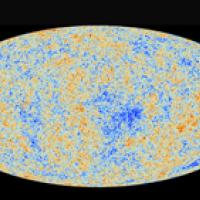
Who's watching: The cosmic microwave background
Few observations have given as profound an insight into the workings of our Universe as the detection of the cosmic microwave background (CMB). This faint glow, which originated in the Big Bang, not only confirms that the Big Bang happened at all, it also tells us what the Universe is made of, when the seeds for the matter within it were sown, what shape it is, and what its future is likely to be.
How can a single picture reveal so much? This collection of articles gives a comprehensive entry-level overview of the CMB and its oracle-like status, an introduction to the models cosmologists use to understand our Universe, and some relevant background reading. Enjoy!
Articles
The cosmic afterglow — The cosmic microwave background is the earliest light we can see in the Universe. So important is this baby picture of the Universe, it's been involved in two Nobel Prizes. Why?
The cosmic soup — To understand the CMB picture you first need to understand what physicists believe created it: sound waves travelling through the particle soup that filled the early Universe.
Cosmic peaks — Some of the Universe's most important secrets are hidden in the shape of a beautiful undulating curve: the power spectrum of the CMB.

Cosmic models — Cosmology has an ambitious goal: to understand the Universe in its entirety, trace its evolution, and possibly even predict its future. It's centred around cosmological models that are based on Einstein's theory of gravity.
Background reading
Maths in a minute: Einstein's general theory of relativity — What would happen if the Sun suddenly exploded? Einstein wondered the same thing, and completely changed our understanding of the Universe.
Maths in a minute: Dark matter — What's dark matter and how do we know it's there? Here is a quick introduction.
Maths in a minute: Dark energy — What is dark energy and how do we know it's there? Here is a quick introduction.
The shape and fate of the Universe — How will the Universe end? In a big crunch? Or a big freeze? It all depends on its shape...
Cosmic sound — How to take apart the cosmic microwave background using mathematics that is also used to analyse sound.
If the Universe is expanding, then what is it expanding into? — Since the Universe is all there is, there's nothing for it to expand into. So what does "expansion" mean?
This package is part of our Who's watching? The physics of observers project, run in collaboration with FQXi. Click here to see more articles and videos about questions to do with observers in physics.